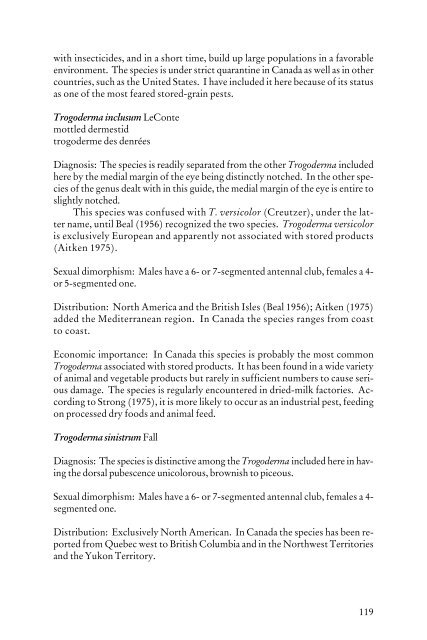Beetles Identification Guide
Beetles Identification Guide
Beetles Identification Guide
You also want an ePaper? Increase the reach of your titles
YUMPU automatically turns print PDFs into web optimized ePapers that Google loves.
with insecticides, and in a short time, build up large populations in a favorable<br />
environment. The species is under strict quarantine in Canada as well as in other<br />
countries, such as the United States. I have included it here because of its status<br />
as one of the most feared stored-grain pests.<br />
Trogoderma inclusum LeConte<br />
mottled dermestid<br />
trogoderme des denrées<br />
Diagnosis: The species is readily separated from the other Trogoderma included<br />
here by the medial margin of the eye being distinctly notched. In the other species<br />
of the genus dealt with in this guide, the medial margin of the eye is entire to<br />
slightly notched.<br />
This species was confused with T. versicolor (Creutzer), under the latter<br />
name, until Beal (1956) recognized the two species. Trogoderma versicolor<br />
is exclusively European and apparently not associated with stored products<br />
(Aitken 1975).<br />
Sexual dimorphism: Males have a 6- or 7-segmented antennal club, females a 4or<br />
5-segmented one.<br />
Distribution: North America and the British Isles (Beal 1956); Aitken (1975)<br />
added the Mediterranean region. In Canada the species ranges from coast<br />
to coast.<br />
Economic importance: In Canada this species is probably the most common<br />
Trogoderma associated with stored products. It has been found in a wide variety<br />
of animal and vegetable products but rarely in sufficient numbers to cause serious<br />
damage. The species is regularly encountered in dried-milk factories. According<br />
to Strong (1975), it is more likely to occur as an industrial pest, feeding<br />
on processed dry foods and animal feed.<br />
Trogoderma sinistrum Fall<br />
Diagnosis: The species is distinctive among the Trogoderma included here in having<br />
the dorsal pubescence unicolorous, brownish to piceous.<br />
Sexual dimorphism: Males have a 6- or 7-segmented antennal club, females a 4segmented<br />
one.<br />
Distribution: Exclusively North American. In Canada the species has been reported<br />
from Quebec west to British Columbia and in the Northwest Territories<br />
and the Yukon Territory.<br />
119
















